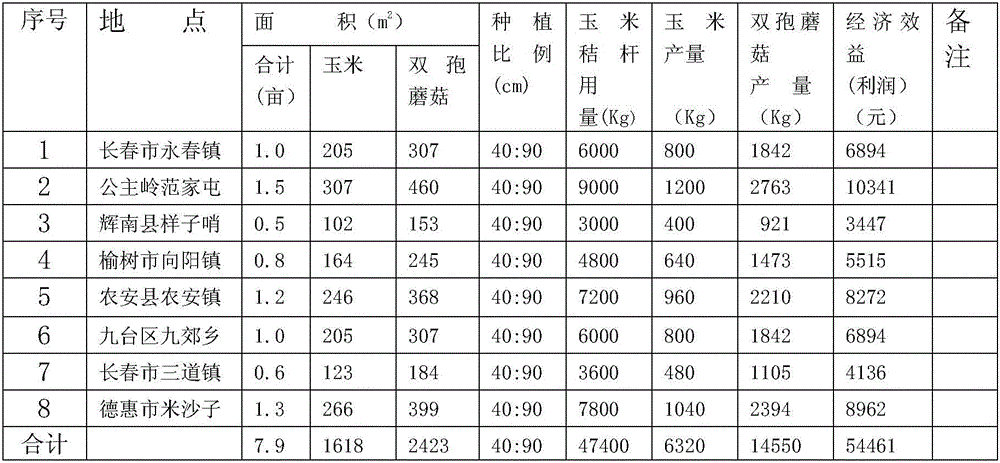Cultivation method for intercropping and interplanting agaricus bisporus in corn fields
A technology of Agaricus bisporus and its cultivation method, which is applied in the field of intercropping cultivation of corn and Agaricus bisporus, can solve the problems of seasonal labor surplus, difficult handling of corn stalks, air pollution, etc., reduce water transpiration, and enhance moisture conservation Drought resistance, effect of increasing yield
- Summary
- Abstract
- Description
- Claims
- Application Information
AI Technical Summary
Problems solved by technology
Method used
Image
Examples
Embodiment 1
[0099] Realize the intercropping of corn and Agaricus bisporus intercropping in large and small ridges. The ratio of large and small ridges is: small ridges of 30cm to 60cm for corn, large ridges of 100cm to 70cm for Agaricus bisporus, and corn on small ridges of 30cm to 60cm. Plant 4,000 corn plants per mu. Sow on May 1st to ensure that the number of corn plants per mu is relatively stable at 4,000 plants. The difference is that the plant spacing is different. The smaller the ridge, the smaller the plant spacing and the greater the density. The main reason is to ensure that the corn yield per unit area does not decrease. In case of a slight decrease, increase the planting area of Agaricus bisporus, and the yield per mu of corn will be about 800kg per mu; Agaricus bisporus will be piled up on June 15, and the material will be sown on July 15, and the row spacing of Agaricus bisporus will be 100cm-70cm. , 20kg of corn stalks and cow dung as compost per square meter, effective ...
Embodiment 2
[0101] The corn and Agaricus bisporus intercropping cultivation method of the present invention, the corn and Agaricus bisporus are planted according to the following optimal ratios: a small ridge of 40 cm for corn, and a large ridge of 90 cm for Agaricus bisporus; See Example 1 for sowing corn and Agaricus bisporus.
[0102] Plant double rows of corn in a 40cm small ridge, plant 7.8 corns per meter in double rows, and plant 4002 corns per mu, about 4000 corns per mu. Such spacing between plants and rows does not have much impact on the growth and development of corn In addition, each small ridge of corn has a 90cm large ridge for ventilation and light transmission, which creates more favorable conditions for the growth and development of corn, so the yield of corn will not be greatly reduced. The yield is flat or slightly reduced, and the yield per mu can generally reach 800kg. level; but each mu increased by 307m 2 For the cultivation area of Agaricus bisporus, use 20kg of...
Embodiment 3
[0104] The corn and Agaricus bisporus intercropping cultivation method of the present invention, corn and Agaricus bisporus are planted according to the following optimal ratios: a small ridge of 50 cm for corn, and a large ridge of 80 cm for Agaricus bisporus; see Example 1 for sowing corn and Agaricus bisporus.
[0105] Above-mentioned according to the cultivation method of embodiment 1, carry out corn and Agaricus bisporus plantation, the small ridge corn per acre guarantees about 4000 plants, the large ridge Agaricus bisporus uses 20 kilograms of corn stalks and cow dung compost per square meter, and the same corn stalks per mu Interplanting with Agaricus bisporus can obtain 800kg of corn, and 6kg of Agaricus bisporus can be harvested per square meter. The use of corn stalks, economic benefits and improvement of soil fertility will all have satisfactory results.
PUM
| Property | Measurement | Unit |
|---|---|---|
| Ridge width | aaaaa | aaaaa |
| Ridge width | aaaaa | aaaaa |
| Thickness | aaaaa | aaaaa |
Abstract
Description
Claims
Application Information
 Login to View More
Login to View More - R&D
- Intellectual Property
- Life Sciences
- Materials
- Tech Scout
- Unparalleled Data Quality
- Higher Quality Content
- 60% Fewer Hallucinations
Browse by: Latest US Patents, China's latest patents, Technical Efficacy Thesaurus, Application Domain, Technology Topic, Popular Technical Reports.
© 2025 PatSnap. All rights reserved.Legal|Privacy policy|Modern Slavery Act Transparency Statement|Sitemap|About US| Contact US: help@patsnap.com

